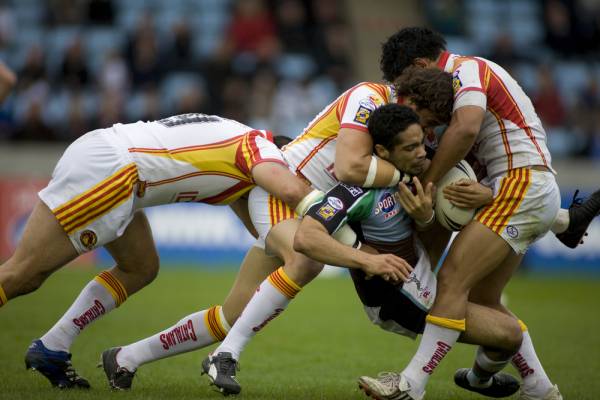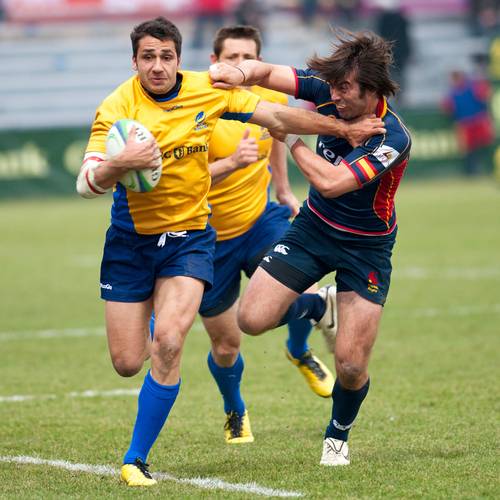Rugby league is a brutal full contact sport where athleticism meets violence. It’s a tough game played by hard men – the strong dominate and the weak cry to the media. Every weekend I am in complete awe at the astonishing acts of skill and athleticism displayed by its players. While elite rugby league players have all the time in the world to develop their physical attributes, I’m banking on our average reader to have limited time to train around busy schedules. So whether you’re a rugby player or not, for those of you who want to look and feel athletic I’ll show you how to get the job done in only two days per week.
Before We Get Started
Because you’re only training two days a week, you have to make those workouts count. Make sure your mind is clear and focused on the task at hand. We may be only training two days per week but we need two workouts per day – one in the morning and one later on that day or night. Testosterone levels have been found to peak between twenty and fifty minutes after the initiation of exercise, it’s for this reason we’ll perform shorter, more frequent workouts.
A big portion of your results will not come from the program itself, but the effort and commitment in which you dedicate yourself. A program can never predict how your body will react on a day-by-day basis, so I won’t give you a program. I’ll outline a basic template. This enables you to personalize the template specifically for YOU.
Let’s Hit It
I believe the basic lifts are the best and most efficient ways to develop the human body for athletic success. The typical way a strength coach will build a power athlete is with a combination of speed and maximal strength training. Maximal strength is foundational to all other elements of athleticism (power, speed, agility, etc.). As such a player with higher levels of maximal strength tends also be more efficient within their chosen sport.
What Is Maximal Strength?
 Maximal strength is your ability to produce the highest level of force possible. Based on motor unit physiology, after ten seconds, your ability to maintain maximum continuous force has been shown to decrease. So any set or exercise that lasts longer than ten seconds of continuous tension isn’t directly training maximal strength.1 In general, maximum strength is best developed with 1-5 repetitions using loads above 90% of 1RM, and a combination of concentric and eccentric muscle actions, 3-6 sets per session, 3-6 exercises per session, also allowing for longer rest periods.
Maximal strength is your ability to produce the highest level of force possible. Based on motor unit physiology, after ten seconds, your ability to maintain maximum continuous force has been shown to decrease. So any set or exercise that lasts longer than ten seconds of continuous tension isn’t directly training maximal strength.1 In general, maximum strength is best developed with 1-5 repetitions using loads above 90% of 1RM, and a combination of concentric and eccentric muscle actions, 3-6 sets per session, 3-6 exercises per session, also allowing for longer rest periods.
You must have built a solid foundation of strength before you can incorporate specific speed work in your program. I’d say a solid foundation of strength would equate to a 1.25x body weight bench press, 1.5x body weight squat, and 1.75x body weight deadlift.
Our Pre Lifting Prep
Self-myofascial release techniques prior to a workout can help to decrease muscle density and allow for better warm-up. Use foam rolling for myofascial release, include a dynamic warm ups to add range of motion and activate dormant muscles. For mobility, it’s important to focus on exercises that open up the hips and thoracic spine. Also include some stretching for chronically tight areas.
How to Lift
Every time you lift a bar, you must lift as fast as possible. The faster you lift a weight, the more you’re going to activate the nervous system and the high threshold motor units (HTMU). You’re probably thinking to yourself “What the hell are high threshold motor units?”
 Your muscle fibers work together in groups or units to perform movements. High threshold motor units are the strongest groups of muscle fibers in the human body, but they’re only used for the most difficult tasks. That means you must push yourself in order to reach the level of intensity needed to recruit these high threshold muscle fibers, and the more you do that, the more you’ll potentiate your body to get a physiological response to build strength. Obviously when the weight gets heavier the bar won’t move as fast, but it’s the intent to accelerate is what’s important.
Your muscle fibers work together in groups or units to perform movements. High threshold motor units are the strongest groups of muscle fibers in the human body, but they’re only used for the most difficult tasks. That means you must push yourself in order to reach the level of intensity needed to recruit these high threshold muscle fibers, and the more you do that, the more you’ll potentiate your body to get a physiological response to build strength. Obviously when the weight gets heavier the bar won’t move as fast, but it’s the intent to accelerate is what’s important.
You’ll start the lifting sequence using sub-maximal loads (Under 70% 1RM), and slowly increase the weight by 5-10% 1RM with every set until 85-90% 1RM has been reached. At this point you’ll begin your official work set. Your lifting sequence for the technical – or high skill and non-power – strength based exercises ONLY should look something like below. In this case we’ll use a technical lift as an example.
- 60% 1RM x 6 Repetitions
- 70% 1RM x 5 Repetitions
- 80% 1RM x 3 Repetitions
- 85-90% 1RM x 3-5 Repetitions (1st official work set)
- 90% 1RM x 3-5 Repetitions (2nd official work set)
- 95% 1RM x 3-5 Repetitions (3rd official work set)
Order of Exercises
The order we select our exercises can have a substantial impact on how our bodies adapt to the training template. We prioritize the most important areas for when the body is fresh and most efficient at learning. Technical or high skill type exercises should always be performed first. When we execute a new movement we are creating a sequence of nerve impulses specific to that movement. The more we practice that neurological sequence, the better that brain learns that particular movement pattern.
After our technical work, our speed and/or ballistic work should be performed next. Our non-power, strength based exercises should be performed third in this continuum, leaving our assistance or isolation exercises to be performed last. If the exercise doesn’t serve a function, leave it out. Our exercise continuum looks like this:
- Technical or high skill, Olympic style lifts, clean or snatch variations/progressions.
- Speed and/or ballistic, plyometrics, bodyweight, medicine ball drills.
- Non-power strength based, compound movements, lower/upper body pressing and pulling.
- Assistance or isolation, pre/rehabilitation, self selection.
CREATE YOUR OWN PROGRAM
Warm Up: Self-myofascial release (foam roller or tennis ball), a dynamic flexibility/mobility circuit followed by some stretching for chronically tight areas.
- a) Olympic style lifts | 3 X 3-5
- b1) Plyometrics | Medicine ball based | 3 X 3-5 (superset)
- b2) Plyometrics | Bodyweight | 3 X 3-5 (superset)
- c) Compound movements | Lower/upper body press | 4 X 3-6
- d) Compound movements | Lower/upper body pull | 4 X 3-6
- e. Pre/rehabilitation exercises. This is really dependant on the individual. Pick 2 exercises 2 X 8-12
Template Notes:
- Every time you lift a bar, you must lift as fast as possible.
- Lower body press = Squat. Upper body press = horizontal or vertical press.
- Lower body pull = Deadlift. Upper body pull = horizontal or vertical row.
- There are no rest interval prescriptions for this program. You should attempt the next set as soon as you feel capable of performing the set well without a drop-off in performance.
Rugby league players must possess power, strength, speed, dynamic flexibility, agility, balance, coordination, and overall athleticism. If your goal is to look and feel athletic, then this is the perfected the strategy to achieve it. And for those of you who play other sports, if your strength and conditioning needs look similar to those of rugby players, you might give this program a try, too.
Photos courtesy of Shutterstock.






